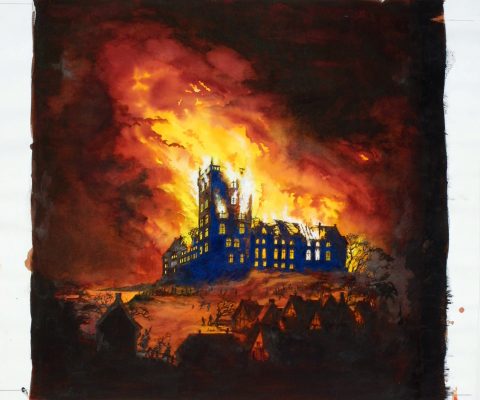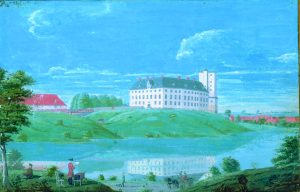The fire of 1808
”Do not take fright, but the castle is burning.”
With these words the maid woke her lady at four thirty in the morning on Wednesday the 30th March 1808. The castle was Koldinghus, and the lady was the colonel’s wife, Mrs Hviid. The family lived in the old County Commissioner’s residence in the basement of the castle’s South Wing, but since the English disembarkment on Zealand in August 1807, and the bombardment of Copenhagen earlier in September, the country had been at war, and Colonel Hviid had therefore been forced to leave his family at Koldinghus while he served king and country.
The effects of war had been felt in Kolding too, where the old, dilapidated castle had been opened as quarters for a small part of the around 25,000 French and Spanish soldiers which the alliance with Napoleon had brought to the country, and it had also become the headquarters for the commander-in-chief of the auxiliary troops, the French marshal Jean-Baptiste Bernadotte.
The fire risk which the presence of the soldiers created was a worry at the castle, and six of the town’s master builders had therefore been chosen to take turns keeping firewatch two by two at night.
On the night of the fire, smoke had long been smelt, but it was at first thought to come from the fireplace which often smoked when the wind blew from a certain direction. The following inquiry showed that the watchmen had not taken their duties very seriously, for neither of the two who should have been on guard had been present when the accident happened.
Søren Weile, a builder, had gone home around two or three in the morning, apparently to ”fetch some refreshments”, but did not return until he was fetched an hour later by the castle’s porter, who said that things were badly awry in the guardroom. Carpenter Beiker hadn’t taken his shift at all bacause he was ill, but had forgotten to send a message.
Besides, he and the other watchmen did what they could when they were called upon sometime during the early hours. The whole episode stinks of negligence, but the decision was made let that side of the matter rest. It was of course sound fellows who were involved.
When the builder had been brought back to the castle around quarter to four, he had established that there was a smell of burning, and that the smell came from the guardroom. Dyring, a painter, another of the watchmen who had since arrived, had forced entry in spite of the protests of the Spanish soldiers, but could not see fire.
They had thereafter taken water with them and gone up to the second storey, where they broke down the door to the room over the guardroom, and here there was so much smoke that they could not see the light from the fire lamps. The water was thrown across the floor, and Dyring’s son, who had come along to see what was happening, was charged with shouting ”fire in the castle”.
In the meantime, fire had broken out in the guardroom, and one of the watchmen had woken the castle steward Christian’s wife with a shout of ”Fire, fire”. She had at first thought that they wanted to fire up in the fireplace, but quickly understood the nature of the case. The castle’s hand-drawn fire engine was already in action, and when the town’s fire engine arrived soon afterwards, the flames were coming out of three windows on the second storey.
In the newspapers it could later be read that Marshal Bernadotte had his people form a chain down to the castle lake, which was frozen over so that a hole had first to be broken in order to get water. Three hours later help arrived from Fredericia and Christiansfeld, and thanks to this assistance the Stableyard was saved from being ignited by the sparks.
The castle itself, however, was not to be saved, and during the day half of Christian IV’s Great Tower fell down through the Great Hall and the Castle Chapel – one of its walls had rested on a wooden construction above the Great Hall’s ceiling.
When Mrs Hviid was woken up the fire had already been raging for some time, and she had therefore to hurry to save her family and furnishings. In a letter which she wrote to her husband later the same day she related:
“Now, my dear husband, we have yet another proof of God’s protection of us! Just think, last night Kolding Castle was ablaze before anyone got up or was told about it. It started at the end by the gate, so that the passage was blocked, but with God’s assistance I was unperturbed and quite peaceful of mind and thought only of salvaging.
Luckily, I immediately thought of the big packing room window. Through it, thanks be to God, we saved everything. Mathilde and I kept together faithfully. In the end, she and I had to follow out of the window, for the gate soon collapsed.
The first thing I thought of was the children. Christiane (Amen) took flight with the child swadled in an eiderdown, Thilde took Bartoline, the maid took Mette, and the governess took the other three, and when they went through the gateway the fire rained down on them.
… I and Thilde stayed with the clothing and the people, and, thank God, we saved the linen, all the pictures, big and small, whole and intact, all our bedclothes, silverware, all carpets, hangings, curtains – don’t we have a reason to thank God?”
From the castle itself were saved a few items of moveable property, but nothing of great value apart from the altar silver from the Castle Chapel, which was sent to the The Royal Silver Vault.
Of the other items ”1 old woven cover featuring Queen Margrethe out hunting and Holger The Dane” is worth mentioning. Unfortunately, it was not put to one side when the the castle steward, at the instigation of the exchequer, looked through the saved items ”in order to establish whether there amongst the old fixtures might be pieces that were worth preserving as antiquities”.
Instead, it was, together with the saved moveable property, including a number of window frames, iron, and fire damaged wood, sold at two auctions which were held the following year. Later, the buyer’s wife sold it on to an itinerant pedlar for next to nothing.
Posterity has been inclined to place the blame for the fire at the feet of the Spanish soldiers at Koldinghus, and it is entirely probable that they, unused to the Nordic winter, fired up all too zealously in the castle’s fireplace. The real casue, however, was sooner the fact that the maintenance of the chimneys had been neglected – but whatever the case may be, Jutland’s last royal castle, which in 1808 still stood in the Baroque form it had attained through Frederik IV’s rebuilding in the years around 1720, had been lost.
At the time, however, people were most occupied by the fact that the fire had ruined large amounts of grain. In all it was estimated at 6,000 barrels of rye and oats, which people then made a great effort to salvage in the hope that it could be used as cattle feed.
Koldinghus was not rebuild as a royal castle, and very quickly became one of the romantic ruins which the age loved. In 1813 Christian Molbech passed by, and he writes:
“Nature, which so likes to beautify death and destruction, had already here and there adorned the red lots with lively grass growth. The castle bailiff’s cow wandered calmly in and out of the windows in search of food on the grass-covered gravel slopes between the walls where courtiers lived in days of old, and in the great, vaulted kitchen where the court was cooked for, a lonely pig had made his spacious dwelling”.
 Dansk
Dansk
 English
English
 Deutsch
Deutsch


